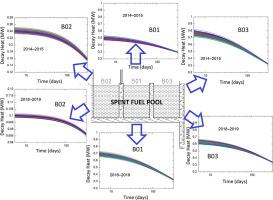当前位置:
X-MOL 学术
›
Nucl. Eng. Des.
›
论文详情
Our official English website, www.x-mol.net, welcomes your
feedback! (Note: you will need to create a separate account there.)
Calculation of decay heat rate in VVER-1000 spent fuel pool including uncertainties
Nuclear Engineering and Design ( IF 1.9 ) Pub Date : 2020-09-01 , DOI: 10.1016/j.nucengdes.2020.110754 Danail Hristov , Plamen V. Petkov , Ivo Naev
Nuclear Engineering and Design ( IF 1.9 ) Pub Date : 2020-09-01 , DOI: 10.1016/j.nucengdes.2020.110754 Danail Hristov , Plamen V. Petkov , Ivo Naev

|
Abstract This paper presents a decay heat rate analysis of the VVER-1000 (unit 6 in “Kozloduy NPP” Plc.) spent fuel pool (SFP) using the method outlined by the United States (US) Nuclear Regulatory Commission (NRC) Regulatory Guide (RG) 3.54 (Revision 2, 2018), titled “Spent Fuel Heat Generation in an Independent Spent Fuel Storage Installation.” The usage of RG 3.54 for SFP calculations is extremely attractive because it enables fast determination of the decay status of a large number of stored fuel assemblies (FAs) in an SFP and further evaluation of their uncertainties. Two batches of fuel FAs in an SFP were analyzed in the study: The first batch consisted of 402 FAs that were stored for 321 days of reactor power operation from 2014 to 2015. The second batch consisted of 355 FAs that were stored for 326 days of reactor power operation from 2018 to 2019. The total decay heat rate and the corresponding decay heat rates of the FA that was placed in each of three VVER-1000 SFP sections were evaluated. Additionally, the propagation of the input uncertainties introduced by the initial fuel mass, burnup, and operation time on full power effective days was estimated. The applied method was derived from the uncertainty method, which was previously introduced by Gesellschaft fur Anlagen-und Reaktorsicherheit (GRS), for free from deliberate pessimism safety analyses (named best estimate). The variation in the selected input parameters produced decay heat generation uncertainty as follows: ±73.2 kW (2014)/±59.1 kW (2018) at the beginning of each batch storage, and correspondingly, ±12.0 kW (2015)/±10.7 kW (2019) at the end of each batch storage. The results indicate that the method is sufficiently sensitive to the initial mass variation and irradiation uncertainties. The degree of conservatism (via a parameter referred to as a ‘safety factor’), introduced in RG 3.54 to address the numerical and nuclear data uncertainties in pressurized water reactor (PWR) decay heat calculations, was calculated for the stored VVER-1000 FA. An original approach for calculation of the scaling coefficient kcorr is suggested in the paper for estimation of the level of conservatism using the safety factor in RG 3.54 and other sources. The obtained results are reported. The recommendations by RG 3.54 were implemented in an input script for the MAXIMA Computer Algebra System (CAS). The MAXIMA CAS calculations of the VVER-1000 SFP decay heat rate were verified with the corresponding Oak Ridge Isotope Generation (ORIGEN) (SCALE 6.1) data at the beginning and end of the analyzed time periods. The authors determined that the obtained values of kcorr = 0.91–0.93 are useful in the re-evaluation of the RG 3.54 degree of conservatism. Furthermore, the scaled safety factor decay heat generation output was replaced with the calculated upper uncertainty bound. The upper boundary values in the decay heat rate uncertainty range showed flexibility and reduced conservatism in comparison with the upper 10% of the conservative bound of the nominal values.
中文翻译:

包括不确定性在内的 VVER-1000 乏燃料池衰变热率的计算
摘要 本文介绍了使用美国 (US) 核管理委员会 (NRC) 监管指南概述的方法对 VVER-1000(“Kozloduy NPP” Plc. 中的第 6 单元)乏燃料池 (SFP) 进行衰变热率分析(RG) 3.54(2018 年第 2 版),标题为“独立乏燃料储存装置中的乏燃料热产生”。使用 RG 3.54 进行 SFP 计算非常有吸引力,因为它可以快速确定 SFP 中大量储存燃料组件 (FA) 的衰减状态并进一步评估其不确定性。该研究分析了 SFP 中的两批燃料 FA:第一批由 402 种 FA 组成,这些 FA 在 2014 年至 2015 年的反应堆动力运行中储存了 321 天。第二批由 355 个 FA 组成,这些 FA 在 2018 年至 2019 年期间储存了 326 天的反应堆电力运行。 评估了放置在三个 VVER-1000 SFP 部分中的每一个的 FA 的总衰变热率和相应的衰变热率. 此外,还估计了由初始燃料质量、燃耗和全功率有效天数运行时间引入的输入不确定性的传播。应用的方法源自不确定性方法,该方法先前由 Gesellschaft fur Anlagen-und Reaktorsicherheit (GRS) 引入,无需刻意的悲观安全分析(称为最佳估计)。所选输入参数的变化产生的衰变热产生不确定性如下:每批存储开始时±73.2 kW (2014)/±59.1 kW (2018),相应地,±12。每个批次存储结束时为 0 kW (2015)/±10.7 kW (2019)。结果表明该方法对初始质量变化和辐照不确定性足够敏感。保守程度(通过称为“安全系数”的参数),在 RG 3.54 中引入,以解决压水反应堆 (PWR) 衰变热计算中的数值和核数据不确定性,是为存储的 VVER-1000 FA 计算的. 使用 RG 3.54 和其他来源中的安全系数估计保守性水平的论文中建议了一种计算缩放系数 kcorr 的原始方法。报告获得的结果。RG 3.54 的建议已在 MAXIMA 计算机代数系统 (CAS) 的输入脚本中实施。VVER-1000 SFP 衰变热率的 MAXIMA CAS 计算在分析时间段的开始和结束时使用相应的橡树岭同位素生成 (ORIGEN) (SCALE 6.1) 数据进行验证。作者确定获得的 kcorr = 0.91–0.93 值可用于重新评估 RG 3.54 的保守度。此外,按比例计算的安全系数衰减发热输出被计算的不确定性上限取代。与标称值保守界限的上 10% 相比,衰变热速率不确定性范围内的上边界值显示出灵活性并降低了保守性。作者确定获得的 kcorr = 0.91–0.93 值可用于重新评估 RG 3.54 的保守度。此外,按比例计算的安全系数衰减发热输出被计算的不确定性上限取代。与标称值保守界限的上 10% 相比,衰变热速率不确定性范围内的上边界值显示出灵活性并降低了保守性。作者确定获得的 kcorr = 0.91–0.93 值可用于重新评估 RG 3.54 的保守度。此外,按比例计算的安全系数衰减发热输出被计算的不确定性上限取代。与标称值保守界限的上 10% 相比,衰变热速率不确定性范围内的上边界值显示出灵活性并降低了保守性。
更新日期:2020-09-01
中文翻译:

包括不确定性在内的 VVER-1000 乏燃料池衰变热率的计算
摘要 本文介绍了使用美国 (US) 核管理委员会 (NRC) 监管指南概述的方法对 VVER-1000(“Kozloduy NPP” Plc. 中的第 6 单元)乏燃料池 (SFP) 进行衰变热率分析(RG) 3.54(2018 年第 2 版),标题为“独立乏燃料储存装置中的乏燃料热产生”。使用 RG 3.54 进行 SFP 计算非常有吸引力,因为它可以快速确定 SFP 中大量储存燃料组件 (FA) 的衰减状态并进一步评估其不确定性。该研究分析了 SFP 中的两批燃料 FA:第一批由 402 种 FA 组成,这些 FA 在 2014 年至 2015 年的反应堆动力运行中储存了 321 天。第二批由 355 个 FA 组成,这些 FA 在 2018 年至 2019 年期间储存了 326 天的反应堆电力运行。 评估了放置在三个 VVER-1000 SFP 部分中的每一个的 FA 的总衰变热率和相应的衰变热率. 此外,还估计了由初始燃料质量、燃耗和全功率有效天数运行时间引入的输入不确定性的传播。应用的方法源自不确定性方法,该方法先前由 Gesellschaft fur Anlagen-und Reaktorsicherheit (GRS) 引入,无需刻意的悲观安全分析(称为最佳估计)。所选输入参数的变化产生的衰变热产生不确定性如下:每批存储开始时±73.2 kW (2014)/±59.1 kW (2018),相应地,±12。每个批次存储结束时为 0 kW (2015)/±10.7 kW (2019)。结果表明该方法对初始质量变化和辐照不确定性足够敏感。保守程度(通过称为“安全系数”的参数),在 RG 3.54 中引入,以解决压水反应堆 (PWR) 衰变热计算中的数值和核数据不确定性,是为存储的 VVER-1000 FA 计算的. 使用 RG 3.54 和其他来源中的安全系数估计保守性水平的论文中建议了一种计算缩放系数 kcorr 的原始方法。报告获得的结果。RG 3.54 的建议已在 MAXIMA 计算机代数系统 (CAS) 的输入脚本中实施。VVER-1000 SFP 衰变热率的 MAXIMA CAS 计算在分析时间段的开始和结束时使用相应的橡树岭同位素生成 (ORIGEN) (SCALE 6.1) 数据进行验证。作者确定获得的 kcorr = 0.91–0.93 值可用于重新评估 RG 3.54 的保守度。此外,按比例计算的安全系数衰减发热输出被计算的不确定性上限取代。与标称值保守界限的上 10% 相比,衰变热速率不确定性范围内的上边界值显示出灵活性并降低了保守性。作者确定获得的 kcorr = 0.91–0.93 值可用于重新评估 RG 3.54 的保守度。此外,按比例计算的安全系数衰减发热输出被计算的不确定性上限取代。与标称值保守界限的上 10% 相比,衰变热速率不确定性范围内的上边界值显示出灵活性并降低了保守性。作者确定获得的 kcorr = 0.91–0.93 值可用于重新评估 RG 3.54 的保守度。此外,按比例计算的安全系数衰减发热输出被计算的不确定性上限取代。与标称值保守界限的上 10% 相比,衰变热速率不确定性范围内的上边界值显示出灵活性并降低了保守性。











































 京公网安备 11010802027423号
京公网安备 11010802027423号